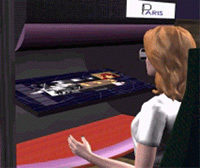Technologies for Virtual Reality / Tele-Immersion Applications: Issues of Research in Image Display and Global Networking
June 1st, 1999
Categories: Devices, Networking, Tele-Immersion, VR

Authors
DeFanti, T., Sandin, D., Brown, M., Pape, D., Anstey, J., Bogucki, M., Dawe, G., Johnson, A., Huang, T.About
EVL has developed an aggressive program over the past decade to partner with scores of computational scientists and engineers all over the world. The focus of this effort has been to create visualization and VR devices and applications for collaborative exploration of scientific and engineering data. Since 1995, our research and development activities have incorporated emerging high bandwidth networks like the vBNS and its international connection point STAR TAP, in an effort now called tele-immersion.
As a result of eight years experience building first and second-generation projection-based VR devices to support these applicaitons, we wish to describe needed research in third-generation VR devices aimed at desktop / office-sized displays. Since no current projection technology is yet configurable with ideal resolution and size, we must first describe the variety of emerging display devices.
In 1991, we conceived and over several years developed the CAVE virutal reality theater, a room-sized, high-resolution, projection-based system that enables users to experience excellent immersion in full 3D imagery. We then developed the ImmersaDesk, a smaller, software-compatible, drafting-table-format version of the CAVE that has been deployed to dozens of locations, nationally and internationally, at government institutions, national laboratories, universities and companies. The hardware now needs to be made smaller, higher resolution and more adaptable to the human and his/her workspace. Middleware that manages connections, bandwidth and latency needs to be integrated with the computer systems driving these hardware devices. Software that increases the quality of human-computer interaction through human output recognition must be brought from specialized lab experiments to routine use, and provided as part of the tele-immersive collaborative experinece. This paper discusses many of the issues at the heart of this research.
Resources
Citation
DeFanti, T., Sandin, D., Brown, M., Pape, D., Anstey, J., Bogucki, M., Dawe, G., Johnson, A., Huang, T., Technologies for Virtual Reality / Tele-Immersion Applications: Issues of Research in Image Display and Global Networking, EC / NSF Workshop on Research Frontiers in Virtual Environments and Human-Centered Computing, Chateau de Bonas, France, Springer Verlag, June 1st, 1999.